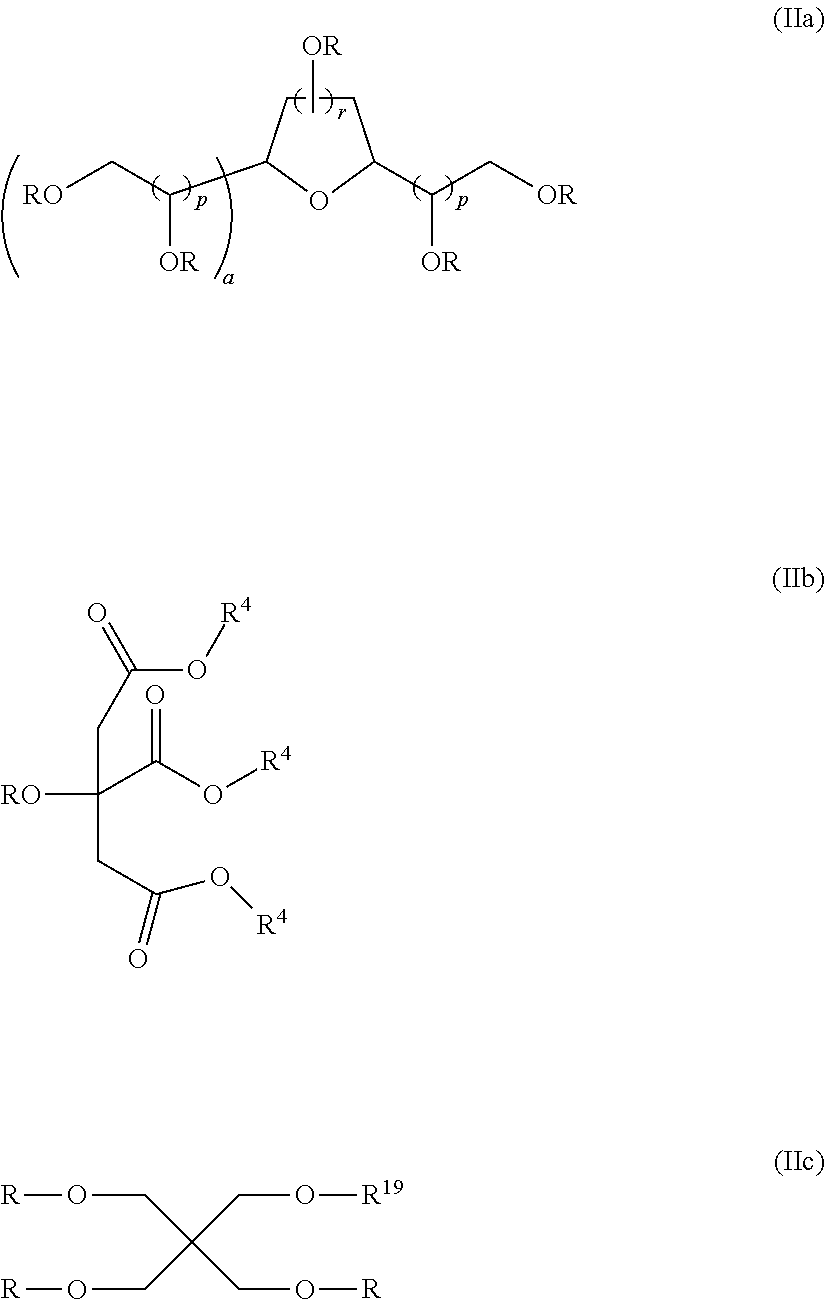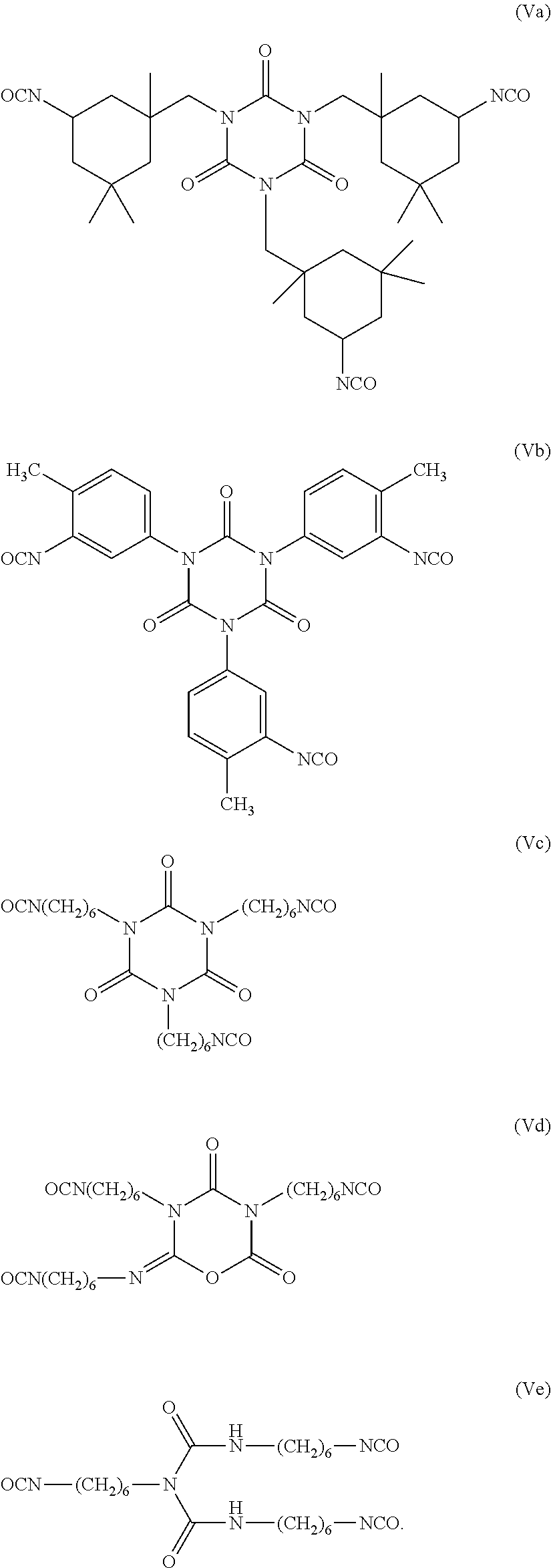Use of non-fluorinated or partially fluorinated urethanes in coatings
a technology of fluorinated urethane and coating, which is applied in the direction of coatings, polyurea/polyurethane coatings, etc., can solve the problems of less effective than fluorinated counterparts, short perfluoroalkyl chains, and lower performance of polymers containing short perfluoroalkyl chains, etc., to reduce surface tension, increase contact angle, and improve wetting resistance
- Summary
- Abstract
- Description
- Claims
- Application Information
AI Technical Summary
Benefits of technology
Problems solved by technology
Method used
Image
Examples
example 1
[0074]A dry 4-neck 500 mL round bottom flask was set up with a thermocouple, mechanical stirrer, a nitrogen inlet, condenser, and gas outlet. The flask was charged with DESMODUR N100 (12.13 g), MIBK (91.3 g), and FeCl3 solution (0.5% by weight in MIBK, 0.25 g). The reaction mixture was heated to 60° C. Sorbitan tristearate (22.28 g), sorbitan trioleate (26.46 g), and sodium carbonate (0.28 g) were added to the flask. The temperature was then raised to 95° C. and the reaction mixture was stirred for 5 hours. Then n-butanol (0.71 g) was added and the reaction was cooled to 80° C. When the reaction tested negative for active isocyanates, warm DI water (246 g), diacetin (11.08 g), CHEMIDEX S (2.89 g), ETHAL LA-4 (1.05 g) and acetic acid (1.48 g) were added and the mixture was stirred for 30 minutes at 75° C. Then the mixture was homogenized for 4 passes at 6000 psi. MIBK was removed via distillation. The product was filtered through a sock filter, diluted to 20.0% solids, standardized t...
example 2
[0075]A dry 4-neck 500 mL round bottom flask was set up with a thermocouple, mechanical stirrer, a nitrogen inlet, condenser, and gas outlet. The flask was charged with DESMODUR N3300 (13.76 g), MIBK (32.5 g), and FeCl3 (0.5% by weight in MIBK, 0.5 g). The reaction mixture was heated to 60° C. MPEG 750 (18.72 g) and Na2CO3 (0.63 g) were added to the flask. The temperature was then raised to 95° C. and stirred for 1 hour. Sorbitan tristearate (19.18 g), sorbitan monostearate (5.06 g), and MIBK (24.2 g) were added to the flask, the temperature was set to 95° C., and the reaction was stirred overnight. When the reaction tested negative for active isocyanates, warm DI water (226.9 g), diacetin (22.7 g), and acetic acid (0.75 g) were added, and the mixture was stirred for 30 minutes at 75° C. The mixture was homogenized for 4 passes at 6000 psi, and MIBK was removed via distillation. The product was filtered through a sock filter, diluted to 20.0% solids, standardized to pH 5.0-5.5, and ...
example 3
[0076]Into a 4-neck round bottom flask equipped with an overhead stirrer, thermocouple and condenser was added sorbitan tristearate (91.7 g) sodium carbonate (1.2 g) and 4-methyl-2-pentanone (MIBK, 125 g). After the solution was heated to 55° C., DESMODUR N100 (25.1 g) was added and the temperature was increased to 80° C. Catalyst was added at 80° C. and then reaction temperature was increased to 95° C. After 6 hours, n-butanol (1.5 g) was added to the reaction mixture. The following morning, the reaction tested negative for active isocyanates.
[0077]An aqueous dispersion of the compound was then prepared. Water (400 g), WITCO C-6094 (15.1 g), and dipropylene glycol (29.4 g) were added to a beaker and stirred to form a surfactant solution. The solution was heated to 65° C. The urethane reaction was cooled to 65° C. and the surfactant solution was slowly added to produce a milky solution. The mixture was blended by immersion blender (2 minutes), homogenized at 6000 psi, and the result...
PUM
| Property | Measurement | Unit |
|---|---|---|
| melting point | aaaaa | aaaaa |
| melting point | aaaaa | aaaaa |
| melting point | aaaaa | aaaaa |
Abstract
Description
Claims
Application Information
 Login to View More
Login to View More - R&D
- Intellectual Property
- Life Sciences
- Materials
- Tech Scout
- Unparalleled Data Quality
- Higher Quality Content
- 60% Fewer Hallucinations
Browse by: Latest US Patents, China's latest patents, Technical Efficacy Thesaurus, Application Domain, Technology Topic, Popular Technical Reports.
© 2025 PatSnap. All rights reserved.Legal|Privacy policy|Modern Slavery Act Transparency Statement|Sitemap|About US| Contact US: help@patsnap.com



